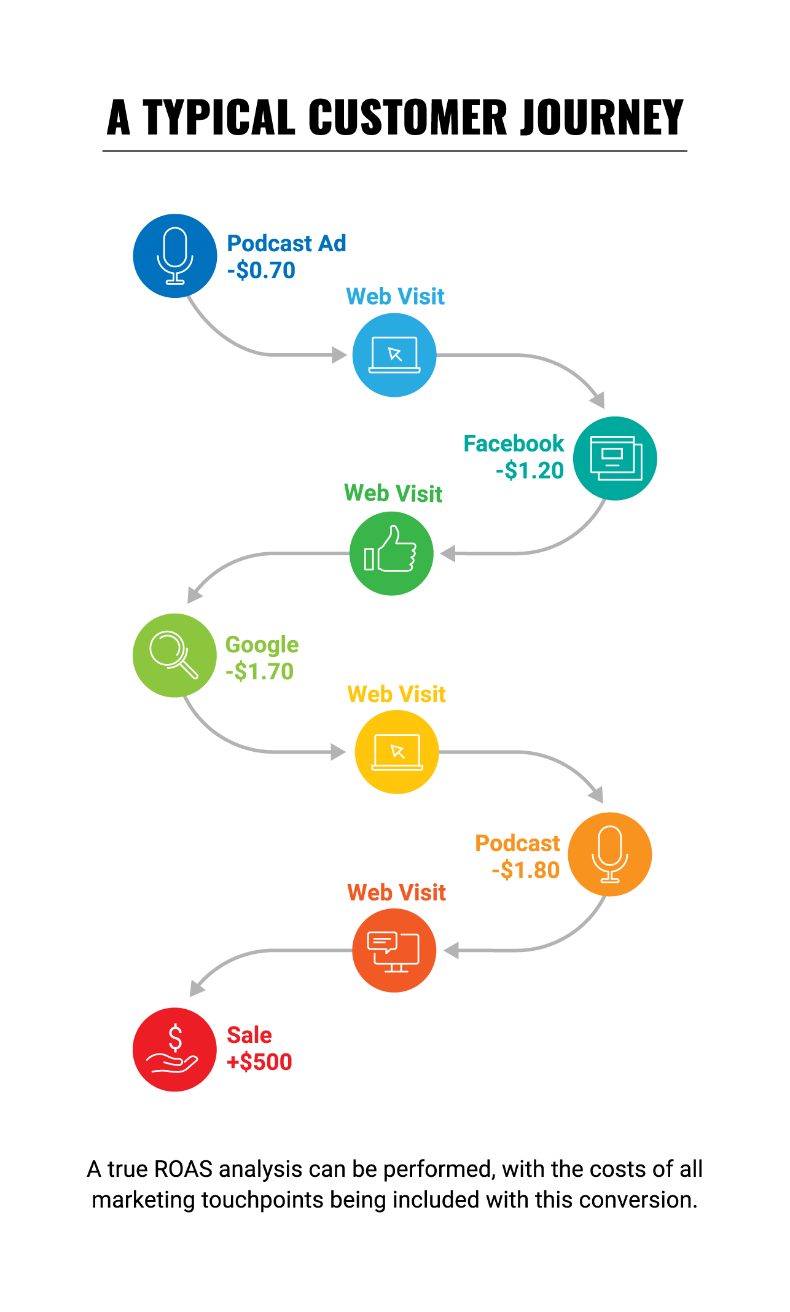The days of running a TV ad, listing an 800 number, and watching sales roll in—clear proof that ad dollars spent equal revenue in—are long gone. That's the traditional paid linear TV campaign: The ad runs. People call within a short window. Sales increase. The ad worked.
That method might still work and contribute to sales, but marketers have many more channels at their disposal—paid and organic social, paid and organic search, streaming audio and podcast ads, OTT/CTV, broadcast radio, SMS text, a newsletter, even tradeshows and cold-calling. There's a good chance marketers—whether B2C or B2B—are and should be advertising on most if not all available paid and nonpaid channels.
But how do you know what is working, and just as important, what is not at driving website traffic and conversions?
Enter multitouch attribution (MTA).
First, let's define it: MTA is a measurement practice used to evaluate each marketing touchpoint's impact during the move toward conversion. The objective is to determine each touchpoint's specific value during the buying journey.
Getting Started With Attribution
It's not as hard as you might think to get started collecting attribution data. It takes only a pixel, placed on your website, to begin gathering data to see where website traffic is coming from. Think of it as monitoring all channels that feed users to your website.
Forrester Research defines cross-channel attribution as the strategic coordination of all marketing channels that a company employs in its strategies. For most marketers, those ad channels include digital, broadcast, streaming, organic, affiliates/influencers, mobile, social, tradeshows, and more.
The beauty is that no matter what your marketing mix is, attribution will measure all channels—online and offline—to assign credit and measure the impact of each individual touchpoint.
In most cases, it is not one channel that does all the work. More likely, two or more channels contribute to a customer journey. A radio ad creates awareness, which leads to consumers' searching Google for that product or company name, at which point they are served up a paid ad for that product or company; or maybe they see an ad while on Instagram or TikTok.
If those consumers visit your website and make a purchase, you can see their journey touchpoint by touchpoint. It's powerful.
Best of all, it's impartial. The pixel plays no favorites to Google ads or paid social ads. It just identifies what people saw and when they saw it, then connects the dots, giving credit where credit is due to each touchpoint on the customer journey.

What Are You Waiting For?
If you are not measuring the performance of your marketing campaigns, you might as well be throwing a dart with a blindfold on. And marketers not using attribution data are going to fall even further behind.
Marketing attribution equips you with the best data available to ensure each and every step of your marketing strategy is informed by reliable, unbiased insights. You can't hope to achieve success if you don't know what online and offline channels have and have not worked in the past. Knowing what is effective, and continually monitoring to see shifts in marketing performance, will properly inform your decisions about new marketing campaigns.
What works one month may not be as effective the next. A holiday, a local or world event, a competitor's campaign—all could influence your marketing. It could be an anomaly, or it could be a trend. By examining the attribution data, you can identify the specific touchpoints that are influencing customers and optimize your ad spend accordingly. By looking back, you can make adjustments today, in real-time.
Without attribution, you are in the dark chasing traffic, clicks, and conversion rates. Attribution shines a light on your strategies and decisions and helps you better delegate your time and resources toward the activities and campaigns that are giving you the most bang for each advertising buck. Attribution makes you a more confident marketer, combining data with your own human experience to make better outcomes.
Impartiality Is Key
If the data you collect isn't truly impartial, it may be pointing you in the wrong direction. Impartiality refers to not only the data that you collect but also the campaigns you run, the channels you pursue, and the types of metrics you measure.
You can't always trust ad networks (e.g., Google or Facebook), unfortunately. Their numbers are skewed to show lots of clicks and views. But are any contributing to your website traffic flow?
The marketing landscape is always changing, and attribution data takes the bias out of measuring marketing performance. You think that one TV ad on that one station during that one program has always worked to drive business traffic, but how do you really know without any data?
Data Creates 'Aha!' Moments
It's eye-opening for marketers when they see actual, impartial attribution data that shows what marketing channel—or, specifically, TV channel—is working.
An example is a furniture retailer that had success with TV advertising but it never really "measured" the advertising's effectiveness beyond knowing it created awareness for its five outlets. It discovered that a certain TV show starring a certain celebrity was the clear-cut winner.
"I was shocked," said the business's e-commerce manager, who was delighted to share the attribution data with the owner, who had done the TV ad buying and was equally surprised. "The show had so many conversions, it was unreal, and it was only two spots. It was an expensive spot, but for the amount of conversions you got, you need to look at buying more of them. People are taking action from this show."
Attribution gave the business the insights, technology, and confidence it needed to deepen its customer relationships and spark improved marketing performance. By examining impartial and transparent attribution data, the marketing team was able to examine its mix of marketing activities with a complete, unified view of its customers' buying journeys. And it could use that data to tweak campaigns to optimize them further.
* * *
Companies using attribution today are improving their return on ad spend, reducing the cost of acquiring customers, and improving lifetime value. Attribution is vital to fueling greater business success, backed up by data and human experience.




